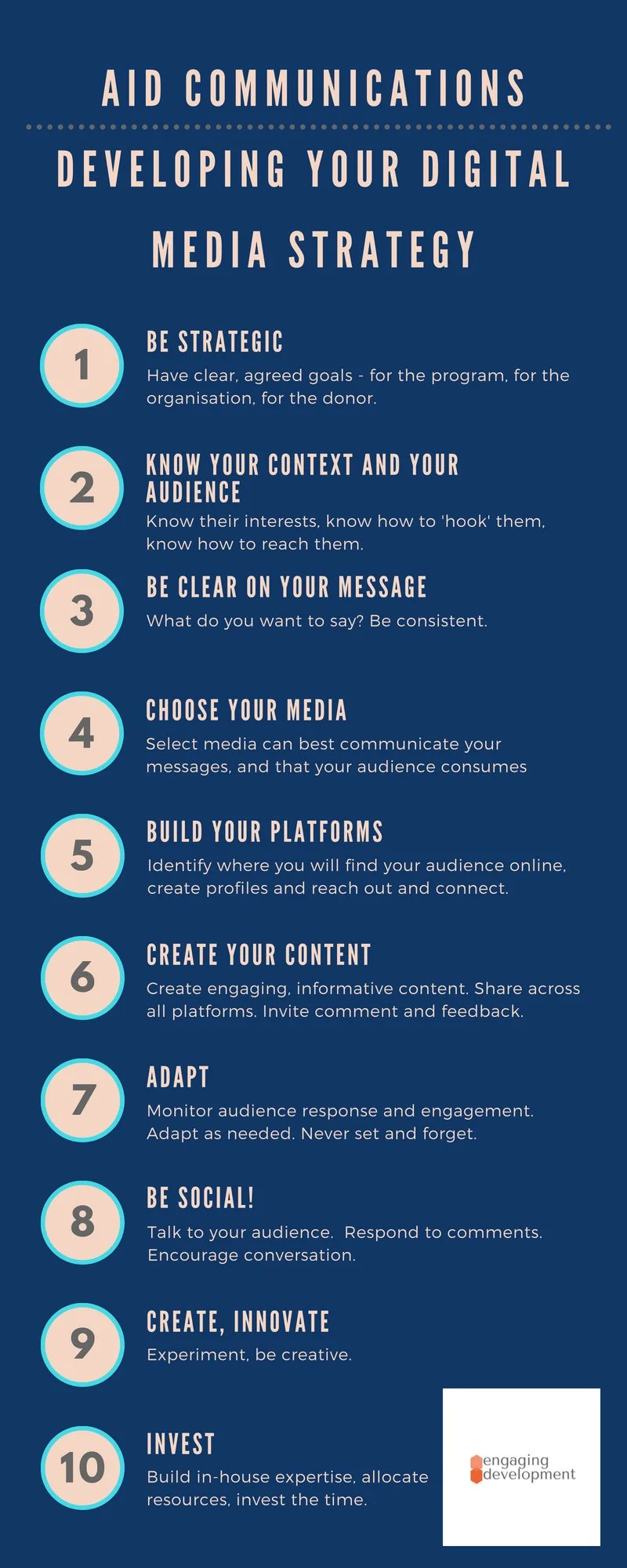Podcast + Blog: Communicating Australian Aid - are we digital enough?
Digital media is finding its way into the Australian aid program, but are we doing enough? Are we grabbing the digital opportunities available to better communicate Australian aid in its entirety?
Australian aid and digital media – an overview
Digital media at the donor level. The Australian Department of Foreign Affairs and Trade (DFAT) launched its Digital Media Strategy 2016-18 in December 2016. A first for DFAT, it has a strong focus on diplomacy, but does not specifically deal with communicating aid. A scroll through the @dfat Twitter account indicates digital media is used to communicate the aid program, but not comprehensively, and there is no dedicated aid social media channel. Videos such as the shared below can be really effective, but more variety, volume and reach is needed to successfully communicate the breadth of Australian aid.
Digital media at the ‘implementer’ level. Australia’s aid program is implemented by a range of organisations, including multilateral agencies, NGOs and private companies. Most have an online presence, but the use of digital media to communicate aid activities varies across organisations, as do audiences. These organisations are well-positioned to contribute to the communication of Australia’s aid program, but digital content is, understandably, often focused on organisational objectives.
Digital media at the program level. The inclusion of digital and traditional media into program communications strategies, while increasingly expected, is often limited to ad-hoc social media updates, or once-off products.
There are unlimited opportunities for rich content to be captured at this level. Content that could be used locally, regionally, and in Australia. What the Australian aid program currently lacks is a means of aggregating, packaging and communicating this content in such a way that it can be used to make the aid program more visible, more accessible, better understood. There is no demand, despite a definite supply.
Why go digital?
Few business, industries or professions could thrive without incorporating digital media and technology into their processes. International aid is no different.
Our audiences are both ‘online’ and ‘offline’, and that is how they need to be communicated with. Digital media can no longer be an ‘add-on’ or a ‘nice-to-have’.
Context is critical
As with everything in international aid and development, context is critical. Slater (2013, p.42) advocates for understanding the ‘communicative ecology’ in a given context before making any commitments to communications approaches and media. This ecology includes communication structures and flows, local communication resources and social networks. Understanding of context should then drive the media and the channels of communication.
Blend your media
Noske-Turner and Tacchi (2016, p.64) researched the integration of digital media technologies into media and communication for development practices. Their research was focused on the Pacific Islands – a priority region for Australian aid and a region with a diverse and fast-changing media and communications landscape. Drawing on Slater’s notion of communicative ecologies, Noske-Turner and Tacchi looked at a range of media and communications projects designed and run by Pacific organisations. They found that while digital media was a key aspect of these projects, it was designed and integrated through a ‘complex blending of analog and digital adapted to suit local communicative ecologies.’
This is key. The ‘communicative ecology’ in Papua New Guinea will differ to that of Vietnam, to that of Fiji, to that of Australia. Aid organisations and programs must ground their communications strategies in the context they are operating in. Digital media should not be used for the sake of it, it’s use must be tailored to the audience.
What about the Australian audience?
Earlier this year, I wrote a blog (Support for Australian Aid, it’s an engagement thing) about the need for those involved in Australia’s international aid program to not only better communicate what they do to the Australian public, but to find ways to engage with audiences beyond those that work in aid.
This engagement is critical to building public understanding and support of the aid program, and to ward off continued budget cuts. I discuss the potential role of digital media to reaching the wider Australian public in the podcast below.
The Australian aid program needs to find ways to better communicate and engage with the Australian public. Digital media has much to offer here, but some creative and sector-wide collaboration is needed. Music 'Atmosphere - Candy-Coloured Sky' by Argofox CC BY 3.0 https://soundcloud.com/argofox/catmosphere-candy-coloured-sky Feature image Created by Lisa Ritchie using Canva www.canva,com References Organisation for Economic Co-operation and Development 2018, OECD Data: Net ODA, retrieved 12 August 2018, https://data.oecd.org/oda/net-oda.htm
What next?
The potential for creative collaboration across agencies, programs, partners and even individuals working within Australian aid is exciting, but a collective, shared vision for communicating the aid program is not in place.
However, even without this shared vision, digital media has much to offer. It does not require fancy tools and equipment but, as highlighted in the below infographic, there are some key steps to ‘digital media success’. With commitment and creativity, digital media can enhance how we communicate Australian aid at all levels.
References
Commonwealth of Australia, DFAT, Digital Media Strategy, retrieved 18 August, 2018, https://dfat.gov.au/about-us/publications/corporate/Documents/digital-media-strategy-2016-18.pdf
Noske-Turner, J & Tacchi, J 2016, ‘Grounding innovation in Pacific Media and communication for development projects,’ Information Technologies and International Development, vol. 12, no, 4, pp 59-69.
Organisation for Economic Co-operation and Development 2018, OECD Data: Net ODA, retrieved 21 August 2018, https://data.oecd.org/oda/net-oda.htm
Slater, D 2013, New Media, Development and Globalization: Making Connections in the Global South, Wiley, retrieved 18 August 2018, ProQuest Ebook Central, https://ebookcentral.proquest.com/lib/deakin/detail.action?docID=1598805.
Featured image (Blog)
Created by Lisa Ritchie using Canva, August 2018
Featured Image (Podcast)
Created by Lisa Ritchie using Canva, August 2018
Music
‘Atmosphere – Candy-Coloured Sky’ by Argofox CC BY 3.0

